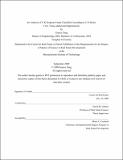An analysis of U.K property funds classified according to U.S styles : core, value-added and opportunistic
Author(s)
Xing, Guoxu
DownloadFull printable version (944.7Kb)
Other Contributors
Massachusetts Institute of Technology. Center for Real Estate. Program in Real Estate Development.
Advisor
David Geltner.
Terms of use
Metadata
Show full item recordAbstract
This analysis explores the feasibility of sorting UK funds into three different styles, which are widely used in the US. In an overview of major factors' impact on the expected risk of a fund, the analysis shows that leverage is by far the most influential factor, followed by the subtype diversification. In a preliminary style-classification, the study uses Loan-to-Value ratio (LTV) as the dominant factor, defining funds with no debt as core, funds with LTV lower than 40% as value-added, and funds with higher than 50% LTV ratios as opportunistic. Then the study makes some adjustments to this classification based on the observation of the funds' attributes other than LTV, and the adjusted classification ends up with 19 core funds, 22 value-added funds and 21 opportunistic funds. After that, three major differences between the UK and US funds are found. First, the core approach represents a smaller portion of the UK funds than the US funds and the opposite is true for the value-added approach. To improve the feasibility of researchers comparing funds within these two countries, the thesis suggests using a fourth style, core-plus. Second, the average LTV for core and value-added approaches is much lower in the UK than in the US. Third, the US opportunistic funds seem to have better performance than their UK counterparts with similar leverage ratio, while future studies would help draw more precise conclusions about the performance comparisons.
Description
Thesis (S.M.)--Massachusetts Institute of Technology, Program in Real Estate Development in Conjunction with the Center for Real Estate , 2009. This electronic version was submitted by the student author. The certified thesis is available in the Institute Archives and Special Collections. Cataloged from student submitted PDF version of thesis. Includes bibliographical references (p. 63).
Date issued
2009Department
Massachusetts Institute of Technology. Center for Real Estate. Program in Real Estate Development.; Massachusetts Institute of Technology. Center for Real EstatePublisher
Massachusetts Institute of Technology
Keywords
Center for Real Estate. Program in Real Estate Development.